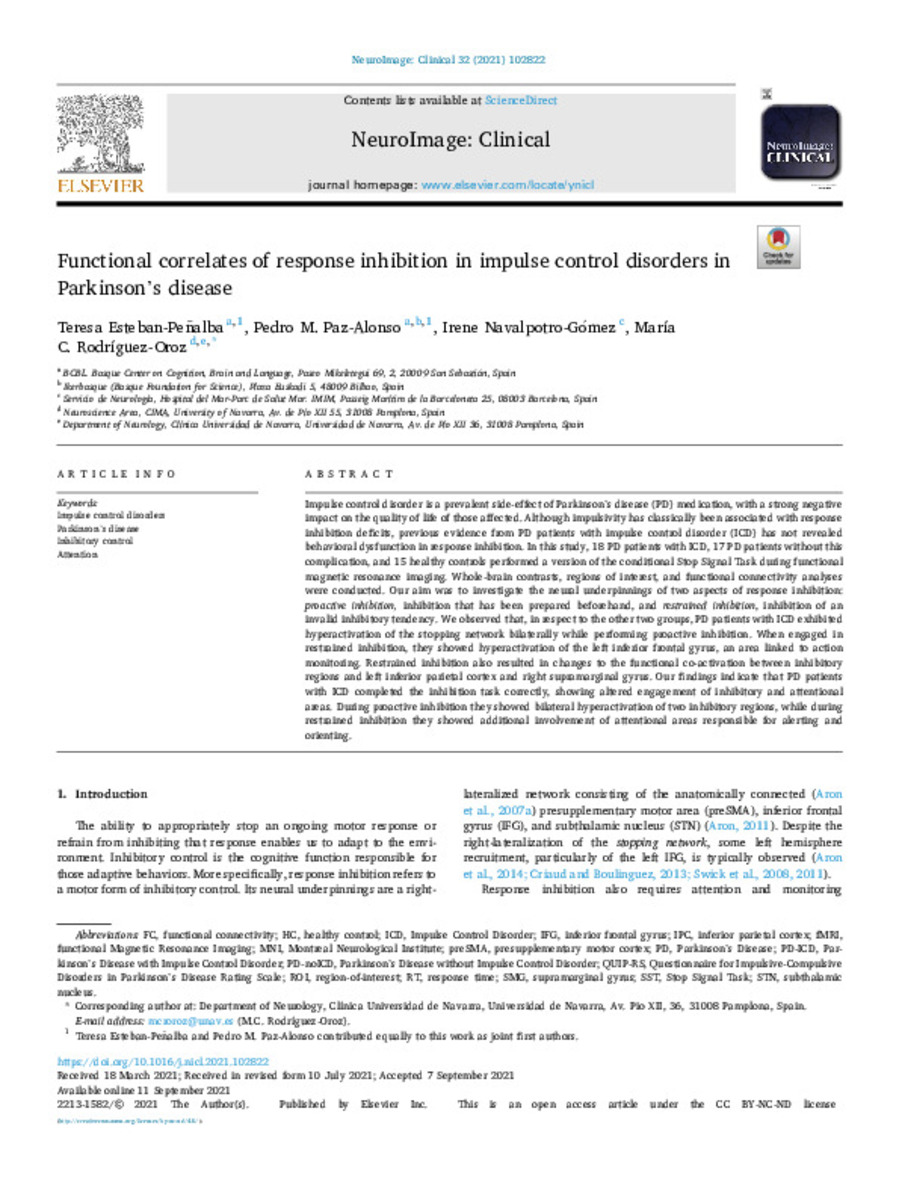Full metadata record
| DC Field | Value | Language |
|---|---|---|
| dc.creator | Esteban-Peñalba, T. (Teresa) | - |
| dc.creator | Paz-Alonso, P. M. (Pedro M.) | - |
| dc.creator | Navalpotro-Gómez, I. (Irene) | - |
| dc.creator | Rodriguez-Oroz, M.C. (María Cruz) | - |
| dc.date.accessioned | 2022-04-25T09:34:40Z | - |
| dc.date.available | 2022-04-25T09:34:40Z | - |
| dc.date.issued | 2021 | - |
| dc.identifier.citation | Esteban-Peñalba, T. (Teresa); Paz-Alonso, P. M. (Pedro M.); Rodriguez-Oroz, M.C. (María Cruz). "Functional correlates of response inhibition in impulse control disorders in Parkinson’s disease". NeuroImage Clinical. (32), 2021, 102822 | es_ES |
| dc.identifier.issn | 2213-1582 | - |
| dc.identifier.uri | https://hdl.handle.net/10171/63408 | - |
| dc.description.abstract | Impulse control disorder is a prevalent side-effect of Parkinson’s disease (PD) medication, with a strong negative impact on the quality of life of those affected. Although impulsivity has classically been associated with response inhibition deficits, previous evidence from PD patients with impulse control disorder (ICD) has not revealed behavioral dysfunction in response inhibition. In this study, 18 PD patients with ICD, 17 PD patients without this complication, and 15 healthy controls performed a version of the conditional Stop Signal Task during functional magnetic resonance imaging. Whole-brain contrasts, regions of interest, and functional connectivity analyses were conducted. Our aim was to investigate the neural underpinnings of two aspects of response inhibition: proactive inhibition, inhibition that has been prepared beforehand, and restrained inhibition, inhibition of an invalid inhibitory tendency. We observed that, in respect to the other two groups, PD patients with ICD exhibited hyperactivation of the stopping network bilaterally while performing proactive inhibition. When engaged in restrained inhibition, they showed hyperactivation of the left inferior frontal gyrus, an area linked to action monitoring. Restrained inhibition also resulted in changes to the functional co-activation between inhibitory regions and left inferior parietal cortex and right supramarginal gyrus. Our findings indicate that PD patients with ICD completed the inhibition task correctly, showing altered engagement of inhibitory and attentional areas. During proactive inhibition they showed bilateral hyperactivation of two inhibitory regions, while during restrained inhibition they showed additional involvement of attentional areas responsible for alerting and orienting | es_ES |
| dc.description.sponsorship | This work was supported by grants from the Carlos III Institute of Health (PI11/02109) and the ERA-Neuron program (PIM2010ERN-0033). Additionally, the authors received the following grants and honoraria: T.E.-P. received a grant from the Spanish Ministry of Economy and Competitiveness (BES-2016-079489). P.M.P.-A. was supported by grants from the Spanish Ministry of Economy and Competitiveness (RYC-2014-15440), the Spanish Ministry of Science and Innovation (PGC2018-093408-B-I00), and the Fundación Tatiana Pérez de Guzmán el Bueno. I.N.-G. was the recipient of a Rio Hortega grant (CM16/00033) from the Carlos III Institute of Health. I.N.-G. received honoraria from Zambon and TEVA for travel and accommodation to attend scientific meetings. M.C.R.-O. received financial support for her research from national and local government institutions in Spain (Carlos III Institute of Health, Basque Country Government, Diputacion Foral Guipuzcoa, and CIBERNED). M.C.R.-O. received honoraria from Zambon, Bial, and Boston Scientific for lectures, travel, and accommodation to attend scientific meetings. BCBL acknowledges support from the Basque Government through the BERC 2018-2021 program. | es_ES |
| dc.language.iso | eng | es_ES |
| dc.publisher | Elsevier | es_ES |
| dc.rights | info:eu-repo/semantics/openAccess | es_ES |
| dc.subject | Impulse control disorders | es_ES |
| dc.subject | Parkinson’s disease | es_ES |
| dc.subject | Inhibitory control | es_ES |
| dc.subject | Attention | es_ES |
| dc.title | Functional correlates of response inhibition in impulse control disorders in Parkinson’s disease | es_ES |
| dc.type | info:eu-repo/semantics/article | es_ES |
| dc.description.note | This is an open access article under the CC BY-NC-ND license | es_ES |
| dc.identifier.doi | 10.1016/j.nicl.2021.102822 | - |
| dadun.citation.number | 32 | es_ES |
| dadun.citation.publicationName | NeuroImage Clinical | es_ES |
| dadun.citation.startingPage | 102822 | es_ES |
Files in This Item:
Statistics and impact
Items in Dadun are protected by copyright, with all rights reserved, unless otherwise indicated.






